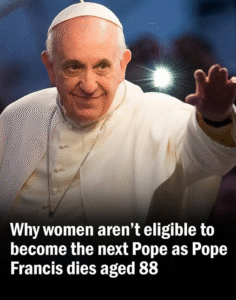Why Women Can’t Become Pope: What Happens After Pope Francis’ Death at 88
With Pope Francis now 88, speculation swirls over what the future holds for the Catholic Church after his passing. While many eyes are on the next papal conclave, one recurring question lingers — can a woman ever become pope? The answer, according to centuries of Catholic tradition and doctrine, remains firmly no.
The pope, by Church law and tradition, must be a male member of the clergy — specifically, a bishop. And since only men can be ordained as priests and bishops in the Roman Catholic Church, women are excluded from the papacy by default. This isn’t merely a custom; it’s rooted in the Church’s interpretation of Scripture and longstanding theological doctrine.
The Catholic Church holds that Jesus chose only men to be his twelve apostles. That decision, Church leaders argue, was deliberate and divinely inspired. Consequently, the priesthood — and by extension, the episcopacy and papacy — has always been reserved for men. Pope John Paul II reaffirmed this in 1994, declaring definitively that the Church “has no authority whatsoever to confer priestly ordination on women.”
Despite calls for reform and growing pressure from some segments of the faithful, the Vatican has repeatedly doubled down on this position. Pope Francis, while seen as progressive on many social issues, has also stated that the door to female ordination remains closed. “The last word was clear and it remains,” he said in 2016.
So, when Pope Francis dies — whether now or in the coming years — the process of choosing his successor will follow ancient protocol. His death will trigger what’s known as “sede vacante,” the period when the papal seat is vacant. During this time, Vatican governance shifts to the College of Cardinals, who will organize the conclave to elect a new pope.
Only cardinals under the age of 80 are eligible to vote — a group that currently numbers just over 100. These cardinals will gather in the Sistine Chapel, taking an oath of secrecy and isolation, and begin the process of selecting a new leader. The decision requires a two-thirds majority, and balloting can take days.
The new pope can be any baptized Catholic male, theoretically even a layman — though in practice, all modern popes have been cardinals. Once chosen, the elected man is asked, “Do you accept your canonical election as Supreme Pontiff?” If he accepts, he is immediately pope, taking a new papal name and stepping onto the balcony of St. Peter’s Basilica to greet the world.
Though women will again be absent from the running, many hope that future popes might at least expand roles for women in leadership. Francis has made small gestures — appointing women to key Vatican departments and opening the door for discussions on female deacons — but full ordination remains off the table.
As the Church prepares for the post-Francis era, the structure remains intact. A new pope will rise from within the College of Cardinals, and for now, the stained-glass ceiling over St. Peter’s remains unbroken.
